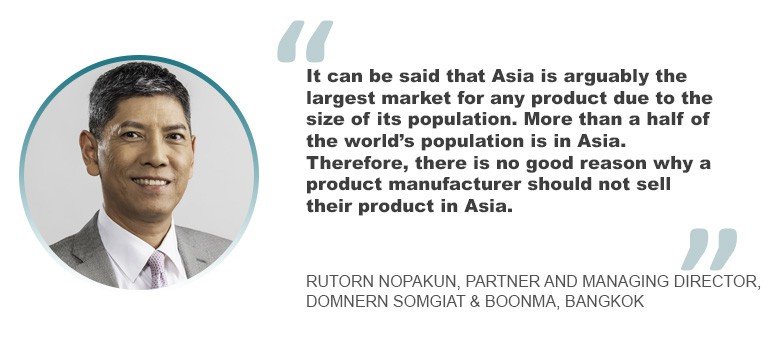Using your IP to launch your product in a new market
31 July 2022

The Covid-19 pandemic has confirmed what we already knew: businesses need to communicate in extremely unique, local terms that are tailored to the needs and conditions of their target consumers. That entails thoroughly comprehending the local circumstances, state-by-state, post code-by-post code, and country-by-country. It might even entail personalizing messages store-by-store for some companies, like banks, restaurants or retailers.
This also applies to launching a product in a new market, given that so much of Asia has so much growth potential. Though the pandemic has been an impediment, GDP growth in developing Asia is expected to stay strong, and converge with its pre-pandemic trend in the near future. According to a report by Morgan Stanley, in China, consumer spending may more than double in the next 10 years, with private consumption set to match that of consumer spending in America.
“It can be said that Asia is arguably the largest market for any product due to the size of its population,” says Rutorn Nopakun, a partner and managing director at Domnern Somgiat & Boonma in Bangkok. “More than a half of the world’s population is in Asia. Therefore, there is no good reason why a product manufacturer should not sell their product in Asia.”

IP considerations and risks
With this in mind, considerations about IP are central to a product launch, especially in a world that is increasingly digital in all aspects and even more so for businesses in tech and innovation.
“Before entering a new market, it is important to understand consumer interest in the product that is being launched,” says Meryl Koh, director of dispute resolution and IP at Drew & Napier in Singapore. “One way to do this is to conduct a survey of the recent IP filing trends in the target market for the particular sector. This would help businesses assess whether there is likely to be interest in the product or if the market is already too saturated for a new entrant. Once a business is satisfied there is consumer interest, searches in local or worldwide IP registries can be done for registered trademarks, patents and/or designs.”
She adds that for more in-depth searches like a freedom to operate (FTO) search, a search may be conducted to zero-in on potential active patents that exist in the target market.
“If there are existing registered IP in a particular market, then businesses would then have to evaluate if there are potential workarounds to co-exist or even engage in a new commercial partnership such as reaching an agreement to license or even cross-license products with the other parties,” she says. “In some cases, this might also mean changing the product such that it avoids infringement or choosing a more viable market for the product launch.”
However, businesses venturing into a new market often face challenges such as differences in culture and language. “This may also manifest in different consumer spending habits and/or user mentalities – a great product in the United States may fare very poorly in Indonesia, for example,” says Koh. “In order to gain foresight into such issues, businesses may consider whether local talent should be involved in every level of management even from the early stages of product development. Hiring local talents who understand the market in their country would help the business in navigating cultural differences and would be important not just for a successful launch of the product but also for the longevity of the business.”
Furthermore, there is a different set of risks for the business after the product has been launched. For example, the functionality and reliability of products may deviate when they are taken out of the sandbox and made to operate under real-world conditions. For some types of businesses, risks such as supply chain disruptions and the entry of competitors into the market may also pose a threat. At the risk of sounding trite, the proverb, “hope for the best, prepare for the worst” comes to mind.
“While businesses should mitigate risk as much as possible, they should accept that there may be roadblocks along the way,” she says. “The most important thing is to stay nimble and be prepared to move in new directions where necessary.”

Using IP to launch product
Pham Nghiem Xuan Bac, a managing partner at Vision & Associates in Hanoi, lists several ways to use IP to launch your product in a new market. He says that a well-formulated IP strategy should be set up based on the understanding of the IP types, the target market interest, the competitors and their IP assets, and the business goals.
“You can use IP as a shield to protect the company from allegations of infringement by third parties and to deter the incursion of would-be infringers – the defensive strategy,” he says. “You also can actively develop and acquire IP rights that gives the company a significant competitive advantage over its competitors in order to block competitors’ market activities in certain fields and to rigorously defend core markets – the offensive strategy. Additionally, you can benefit financially from the commercialization of IP rights, such as buying, selling, licensing, or franchising of the IP assets, depending on the choice of commercialization activities which is the most suitable to your business.”
He adds that before launching a product in a new market, the freedom to commercialize the product therein must be secured.
“To this end, a FTO analysis should be carefully done via searching pending applications and registered IP rights in the target market, obtaining legal opinions on infringement possibility, and deciding the next options such as buying, in-licensing or cross-licensing, or designing around the established IP rights if there are any potential obstacles,” he adds. “In addition, defensive publication (or technical disclosure, which involves disclosing an invention to the public in order to ensure that no one else can patent it) can be used to also provide some degree of freedom to operate.”

It is also necessary to set priorities to your IP assets based on the factors such as the company’s resources/budget, the target market, the expected sales, the risk of non-protection of IP assets and also the expected life-span of IP assets, he says. “You can also consider combining your IP rights for a broader level of protection than either IPR alone could provide,” he says. “For example, a design patent has a protection term of 15 years at maximum, while the protection term of a trademark registration is unlimited. Therefore, you can obtain a design patent together with a trademark registration for the product to provide long-term protection on the product design, so maximizing a business return on investment.”
The importance of registered IP rights should be considered, since registered rights are always easier to enforce than non-registered rights. “Even in case of copyrights which are automatically 3 protected when a work is created, copyright registration with local IP offices is advisable to establish a record date and a proof of work’s ownership, which can be effectively used to support or oppose copyright challenges,” he says. “In addition, spotting infringements should be frequently conducted by market survey in order to detect and settle them as early as possible.”
He concludes: “It is crucial that you should register your potentially valuable IP rights as soon as possible and avoid infringement of others’ established IP rights via conducting clearance search and/or FTO analysis in the target market. In addition, it is important that you should well understand the local IP system, or engage with local IP agents to better deal with IP issues in the target market.”
- Excel V. Dyquiangco






